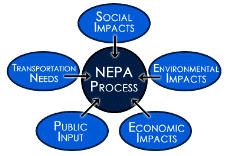Environmental Assessment Section (EAS)



The Environmental Assessment Section of BOEM's Gulf of Mexico Region has been conducting environmental analyses of the effects of the OCS oil and gas development since the inception of the National Environmental Policy Act (NEPA) 42 U.S.C. 4321-4347, as amended in 1969. These NEPA documents may be Environmental Assessments (EA's) or Environmental Impact Statements (EIS's), depending upon the nature of the action in question or the significance of potential impacts associated with the action. To date, GOMR has prepared and published more than 50 draft/final EIS's. The goal of the Environmental Assessment Section has always been to provide factual, reliable, and clear analytical statements in order to inform decision makers, stakeholders, and the public about both the potential beneficial and adverse effects on biological, physical, and sociological resources that could occur as a result of BOEM OCS proposed actions and alternatives to the proposed actions.
Specifically, the Environmental Assessment Section:
- Coordinates and develops all GOMR pre-lease sale NEPA analyses and documents, including both EA’s and EIS’s; provides expert advice to GOMR and HQ management regarding the NEPA process, identifies significant environmental and socioeconomic issues to be addressed in NEPA analyses; and leads reviews of NEPA-related documents prepared by other agencies.
- Conducts all relevant NEPA public outreach, including public scoping meetings and public hearings to collect information from all interested parties.
- Works closely with BOEM’s Resource and Economic Analysis Unit to project future levels of OCS oil and gas related activities; and leads a team of analysts from BOEM’s Biological/Social Sciences Section and Physical/Chemical Sciences Section to conduct analyses assessing potential impacts to environmental resources as a result of proposed OCS oil and gas activities.
- Identifies and resolves conflicts with existing and future uses of the OCS (including oil and gas leases and associated pipelines and infrastructure).
Topics of Special Interest
- National Environmental Policy Act (NEPA) 42 U.S.C. 4321-4347, as amended: In 1970, President Nixon signed into law the National Environmental Policy Act of 1969, an overarching environmental law for Federal agencies, which stipulated that significant federal actions requires federal agencies to incorporate environmental considerations in their planning and decision making through a systematic interdisciplinary approach. Specifically, all Federal agencies are to prepare detailed statements assessing the environmental impact of proposals and alternatives for major actions with the potential to significantly affect the environment.
- Public Participation: BOEM embraces public outreach throughout the NEPA process. Our policy is to ensure transparency and public involvement throughout the entire preparation and implementation of the NEPA procedures. In addition to conducting public meetings during the scoping and public review periods, BOEM posts opportunities for public participation on the Federal Document Management System web page, in the Federal Register, in local newspapers covering the areas that could be potentially affected, and DOI uses other social media outlets such as Facebook and Twitter.
- Coastal Zone Management Act (CZMA) 16 U.S.C. 1451 et seq.: Federal consistency is the CZMA provision that federal actions that have reasonably foreseeable effects on any land or water use or natural resource of the coastal zone (also referred to as coastal uses or resources, or coastal effects) should be consistent with the enforceable policies of a coastal state’s federally approved Coastal Zone Management Program. The CZMA was enacted on October 27, 1972, to encourage coastal states, Great Lake states and U.S. Territories and Commonwealths (collectively referred to as “coastal states” or “states”) to be proactive in managing natural resources for their benefit and the benefit of the Nation. Federal consistency is an important mandatory but flexible mechanism to foster consultation, cooperation and coordination between states and Federal agencies. Federal consistency is more than just a procedural dictate; it helps ensure the balanced use and protection of coastal resources through state Coastal Management Program policies.
- Geological and Geophysical Surveys (G&G): The purpose of G&G is to gather state-of-the-practice data about the ocean bottom and subsurface. EAS conducts the environmental review for introducing exploration technology into new OCS areas for the programs we regulate or for re-evaluating existing programs in mature basins such as the GOM when new information becomes available. These data would provide information about the location and extent of oil and gas resources and reserves, seafloor conditions for oil and gas or renewable energy installations, and marine minerals deposits off the U.S. Atlantic (per Atlantic Geological and Geophysical (G&G) Activities Programmatic Environmental Impact Statement (EIS)) and GOM (per GOM Geological and Geophysical (G&G) Activities Programmatic Environmental Impact Statement (EIS)).
Contact(s):
Gary Goeke—Section Chief
Lissa Lyncker—Unit 1 Supervisor
Tershara Matthews—Unit 2 Supervisor
Bureau of Ocean Energy Management
Gulf of Mexico OCS Region
Office of the Environment
1201 Elmwood Park Boulevard
New Orleans, LA 70123